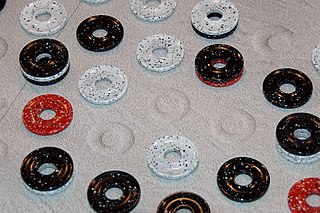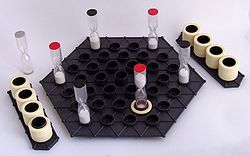
Reversi is a strategy board game for two players, played on an 8×8 uncheckered board. It was invented in 1883. Othello, a variant with a fixed initial setup of the board, was patented in 1971.

Shogi, also known as Japanese chess, is a strategy board game for two players. It is one of the most popular board games in Japan and is in the same family of games as Western chess, chaturanga, xiangqi, Indian chess, and janggi. Shōgi means general's board game.
Breakthrough is an abstract strategy board game invented by Dan Troyka in 2000 and made available as a Zillions of Games file (ZRF). It won the 2001 8x8 Game Design Competition, even though the game was originally played on a 7x7 board, as it is trivially extensible to larger board sizes.

Connect Four is a game in which the players choose a color and then take turns dropping colored tokens into a six-row, seven-column vertically suspended grid. The pieces fall straight down, occupying the lowest available space within the column. The objective of the game is to be the first to form a horizontal, vertical, or diagonal line of four of one's own tokens. It is therefore a type of m,n,k-game with restricted piece placement. Connect Four is a solved game. The first player can always win by playing the right moves.

Quoridor is a two- or four-player intuitive strategy game designed by Mirko Marchesi and published by Gigamic Games. Quoridor received the Mensa Mind Game award in 1997 and the Game Of The Year in the United States, France, Canada and Belgium.

DVONN is a two-player strategy board game in which the objective is to accumulate pieces in stacks. It was released in 2001 by Kris Burm as the fourth game in the GIPF Project. DVONN won the 2002 International Gamers Award and the Games magazine Game of the Year Award in 2003.

Ataxx (アタックス) is a strategy video game published in arcades by Leland Corporation in 1990. Two players compete on a seven-by-seven square grid. The object of the game is for a player to have a majority of the pieces on the board at the end of the game, by converting as many of their opponent's pieces as possible. In a single-player game, the opponents are "bio-invaders from a different dimension."
Arimaa is a two-player strategy board game that was designed to be playable with a standard chess set and difficult for computers while still being easy to learn and fun to play for humans. It was invented between 1997 and 2002 by Omar Syed, an Indian-American computer engineer trained in artificial intelligence. Syed was inspired by Garry Kasparov's defeat at the hands of the chess computer Deep Blue to design a new game which could be played with a standard chess set, would be difficult for computers to play well, but would have rules simple enough for his then four-year-old son Aamir to understand.
The GIPF Project is a series of seven abstract strategy games by designer Kris Burm.

GIPF is an abstract strategy board game by Kris Burm, the first of seven games in his series of games called the GIPF Project. GIPF was recommended by Spiel des Jahres in 1998.

ZÈRTZ is the third game in the GIPF Project of seven abstract strategy games. The game features a shrinking board and an object that promotes sacrifice combinations. It is impartial: since neither player owns on-board pieces, maintaining the initiative is of fundamental importance.

YINSH is an abstract strategy board game by game designer Kris Burm. It is the fifth game to be released in the GIPF Project. At the time of its release in 2003, Burm stated that he intended it to be considered as the sixth and last game of the project, and that the game which he had not yet released, PÜNCT, would be logically the fifth game. However, the series was later expanded to seven games with the release of LYNGK.
Yari shogi is a modern variant of shogi ; however, it is not Japanese. It was invented in 1981 by Christian Freeling of the Netherlands. This game accentuates shogi’s intrinsically forward range of direction by giving most of the pieces the ability to move any number of free squares orthogonally forward like a shogi lance. The opposite is true of promoted pieces which can move backward with the same power.

PÜNCT is a two-player strategy board game. It is the sixth release in the GIPF project of seven abstract strategy games, although it is considered the fifth game in the project. It was released in 2005. PÜNCT won the Games Magazine Best Abstract Strategy game for 2007.

Perfection is a game originally produced by the Pennsylvania company Reed Toys and then by the Milton Bradley company. The object is to put all the pieces into matching holes on the board before the time limit runs out. When time runs out, the board springs up, causing many, if not all, of the pieces to fly out. In the most common version, there are 25 pieces to be placed into a 5×5 grid within 60 seconds.

Ingenious is the English name for Einfach Genial, a German abstract strategy board game designed by Reiner Knizia under commission from Sophisticated Games and published in 2004 by Kosmos. Across most of Europe it is titled as the local translation of Ingenious or Simply Ingenious, the notable exception being Mensa Connections in the UK.

A tile-matching video game is a type of puzzle video game where the player manipulates tiles in order to make them disappear according to a matching criterion. In many tile-matching games, that criterion is to place a given number of tiles of the same type so that they adjoin each other. That number is often three, and these games are called match-three games.

Hostage chess is a chess variant invented by John A. Leslie in 1997. Captured pieces are not eliminated from the game but can reenter active play through drops, similar to shogi. Unlike shogi, the piece a player may drop is one of their own pieces previously captured by the opponent. In exchange, the player returns a previously captured enemy piece which the opponent may drop on a future turn. This is the characteristic feature of the game.
This glossary of board games explains commonly used terms in board games, in alphabetical order. For a list of board games, see List of board games; for terms specific to chess, see Glossary of chess; for terms specific to chess problems, see Glossary of chess problems.
Competitive play in Pokémon generally involves player versus player battles that take place using the Pokémon video games. Players construct a team of Pokémon as defined by a specific set of rules and battle as they would in the game until all Pokémon on a player's team have fainted or when a player resigns. These battles are usually done through the consoles in which the games are played in, or online through fan-made simulators such as Pokémon Showdown!.
















